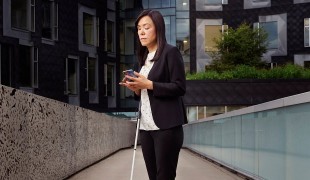- 5602
- 422
- 10
- 10
- 0
- Help Ukraine
About the solution
In 2013, Paul’s visually impaired friend, Tiffany, requested him to create a device that enabled blind people in India to distinguish fake and real currency. It was this request that prompted the creation of the TIFFY template, named after Tiffany.
For the visually impaired in India, it is easy to be tricked into being given different change or wrong notes, seeing as almost all Indian currency notes are the same width, making them extremely hard to differentiate. Each note is supposed to have a marking that represents its denomination, but these markings tend to fade very easily, making the blind and visually impaired a vulnerable target to scam. However, after Tiffany’s request, Paul, who had been developing products for the visually impaired for a number of years, set out to change this.
"As the welfare of the visually impaired is very close to my heart, I dedicated my time to make this device," says Paul.
The device is a small, sleek product that initially was made out of metal but is now made out of the same material used for credit cards, and only takes 45 seconds to use.
A crowd funding platform called Fuel a Dream discovered this product and is trying to make it accessible to the visually impaired across India, enabling the device to be free upon request.
Adapted from: https://www.livemint.com/Leisure/HIcYsC9GkJtS8OveYxO4pN/Note-of-confiden...
https://youtu.be/8QiJXrXQadM
This solution shall not include mention to the use of drugs, chemicals or biologicals (including food); invasive devices; offensive, commercial or inherently dangerous content. This solution was not medically validated. Proceed with caution! If you have any doubts, please consult with a health professional.
DISCLAIMER: This story was written by someone who is not the author of the solution, therefore please be advised that, although it was written with the utmost respect for the innovation and the innovator, there can be some incorrect statements. If you find any errors please contact the patient Innovation team via info@patient-innovation.com
-
-
357
-
0
-
4123

Using AI to allow blind people to find familiar faces
COMMUNICATION: Communicating, whether by speaking, listening, or other means
Social interaction
Blindness
5 Senses support devices: (glasses, hearing aids, headphones...)
Body-Worn solutions (Clothing, accessories, shoes, sensors...)
App (Including when connected with wearable)
AI algorithm
Assistive Daily Life Device (to help ADL)
Difficulty communicating with environment
Confusion
Regaining sensory function
Promoting self-management
Promoting inclusivity and social integration
Improving Speech and Communication
Raise awareness
Ophthalmology
Pediatrics
United States
-
-
-
577
-
0
-
9605

Cane helps blind people recognize faces
COMMUNICATION: Communicating, whether by speaking, listening, or other means
WALKING WITH A WALKING AID: Walking with a walking aid
Urban exploration
Traveling
Social interaction
Blindness
Assistive Daily Life Device (to help ADL)
Walking Aid (wheelchair/walker/crutches)
Vision problems
Sensitivity to light or sound
Restoring mobility
Promoting self-management
Managing Neurological Disorders
Promoting inclusivity and social integration
Maintaining Balance and Mobility
Improving Speech and Communication
Preventing (Vaccination, Protection, Falls, Research/Mapping)
Neurology
Ophthalmology
United Kingdom
-
-
-
470
-
0
-
6510

Blind woman develops several technologies to help the blind
CAREGIVING
Reading
Studying
COMMUNICATION: Communicating, whether by speaking, listening, or other means
Blindness
Assistive Daily Life Device (to help ADL)
Assistive Technology access
Vision problems
Recovering cognitive function
Promoting self-management
Preserving Organ Function
Managing Neurological Disorders
Promoting inclusivity and social integration
To improve Treatment/Therapy
Preventing (Vaccination, Protection, Falls, Research/Mapping)
Ophthalmology
United States
-
 en
en